Van Gogh Museum Journal 1995
(1995)– [tijdschrift] Van Gogh Museum Journal–
[pagina 118]
| |
 fig. 1
Pierre Puvis de Chavannes, Saint Genevieve as a child in prayer, 1875-76, oil on paper, 136.5 × 76.2 cm, signed and inscribed at lower left: au Comte Joseph Primoli affectuesement P. Puvis de C, Amsterdam, Van Gogh Museum | |
[pagina 119]
| |
Pierre Puvis de Chavannes: Saint Genevieve as a child in prayer
| |
[pagina 120]
| |
 fig. 2
Pierre Puvis de Chavannes, Saint Genevieve as a child in prayer, 1877, oil on canvas, 462 × 221 cm, Paris, Panthéon (photograph courtesy of the Caisse nationale des monuments et des sites, Paris) | |
[pagina 121]
| |
circles her head completes the illusion. It is thus that she appears to the naively astonished group.’Ga naar voetnoot4 Like many of Puvis's best painted studies and oil sketches for murals, the Van Gogh Museum version of Saint Genevieve as a child in prayer has a special immediacy and ardour, a sense of the artist's presence in the agility and bluntness of the strokes themselves that is missing from the more careful, drier final mural. Such a work also permits the viewer the special pleasure of examining areas left less than finished, to understand the process of the picture's making, to glimpse the defining lines of the underlying bistre drawing and the hatchings that are key to the minimal shading, as under the thin layer of paint on the woman's arm. One can see the viscous pigment strokes, the dragged and patched colour and the definition of thinned sepia lines that were added with some prowess. The artist's proficiency with a broad technique becomes particularly clear when one examines the sheep and the outlined rocks in the middleground. Although a preparatory work, the Saint Genevieve has the prominent borders upon which the painter set such great store, believing they helped create a special, decorative aesthetic in his work. He first introduced them on independent paintings in the 1867 reduced versions of his first four murals for Amiens.Ga naar voetnoot5 Presentational devices, they permanently frame the imagery and reinforce the idea of adornment for an interior space. They also bring pictorial interest and weight to the far perimeters of the composition. They prepare the way into the work from the exterior wall and bear elements from the central imagery (in abstract form) to its outer edges; further, they give the work a sense of self-sufficiency and completeness. Their ornamentation is an intermediary level of pictorial representation, a halfway place between the exterior world of the architectural and the interior world of figurative tradition. That is, they are a kind of pictorial pivot.Ga naar voetnoot6 Puvis adamantly insisted that such borders were an integral part of his paintings.Ga naar voetnoot7 The borders bracketing the Genevieve imagery are made up of ornamental greenery, ovals and diamonds in a creamy-white field; the last echoes the whites of the sheep, Genevieve's dress, the sky and the foreground rocks, while the gold designs hint at a fleur de lys, the royal flower of France. Puvis warmly inscribed this independent work at the lower left: ‘au Comte Joseph Primoli affectueusement P. Puvis de C’. The bookish Count Joseph (or Giuseppe) Napoleon Primoli (1851-1927), was a Napoleonic descendant through his mother, Carlotta Bonaparte Primoli.Ga naar voetnoot8 A great connoisseur and art collector, he was also a fascinating photographer, recording both the poor of Naples and the rituals of the nobility.Ga naar voetnoot9 He ultimately bequeathed part of his important collection to the city of Rome, thus forming the basis for the Museo Napoleonico. Whether Puvis painted this work for the Count Primoli or dedicated a pre-existing painting to him is not certain; what is clear is that this discerning collector acquired a wonderful painted work. Since Saint Genevieve as a child in prayer is an independent version of a monumental mural for the Paris Panthéon, it can best be understood in the context of the project as a whole. | |
The Panthéon commission: the first campaignBuilt on the site of a former abbey church dedicated to St Genevieve, the patron saint of Paris, the imposing monument known today as the Panthéon, designed by | |
[pagina 122]
| |
Jacques Germain Soufflot in the 18th century, was a church through most of its history.Ga naar voetnoot10 While it lost its religious status after the French Revolution, it was reconsecrated in 1851 under Napoleon III. Its religious designation remained in force until 1885. Under the patronage of Philippe de Chennevières, Director of Fine Arts from 1874 to 1878, some forty separate murals were commissionedGa naar voetnoot11 from such diverse artists as Jean-François Millet, Alexandre Cabanel, Paul Baudry, Léon Bonnat, Jean-Léon Gérôme, Henri Lehmann, and Gustave Moreau.Ga naar voetnoot12 In keeping with policies established during the Second Empire and the notion that the building was both a national monument and the basilica of Sainte Geneviève, and thus a Catholic temple,Ga naar voetnoot13 the programme stipulated that the imagery meld French national and religious history, showing that they overlapped and were codependent. The great religious figures of French history were to be depicted - St Genevieve, Joan of Arc, St Denis - as well as those like Charlemagne and St Louis who, as temporal leaders, had been important in that history. Puvis procured the project of depicting Saint Genevieve in 1874. Securing Puvis's services for a commission in the French capital was rather a bold move on the part of Chennevières: although the artist had had Salon successes and had painted murals for Marseilles (1869) and Poitiers (1874), he had also recently been mocked for the strangeness of his style. An agreement of 15 May 1874 designated the mural subject: the paintings were to depict ‘the education of St Genevieve’ in the lower part between the first pair of columns; ‘the pastoral life of the same saint’ in the lower part between the three others; and, in the upper part of the four intercolumniations, above the stone band, ‘a procession of holy persons.’Ga naar voetnoot14 Puvis's cycle (1874-77) for the Church of St Genevieve, as the Panthéon was then called, consists of ‘l'éducation de Sainte Geneviève’ rendered as a single, prefatory mural entitled Sainte Geneviève enfant en prière - the Saint Genevieve as a child in prayer - and three more murals read together as a triptych, The pastoral life of Saint Genevieve (fig. 3).Ga naar voetnoot15 The commission also included a four panel frieze to surmount the larger compositions. This last, similar to the so-called Panathenées chrétiennes (processionals of saints found in a number of Parisian churches), like the borders surrounding individual works,Ga naar voetnoot16 was required to help unify the commissions, products of the disparate styles of various painters. Both of Puvis's Panthéon projects - this one and the one that would be commissioned in 1896 depicting Genevieve's feats in old age - consist of a single composition coupled with a triad of panels, the whole surmounted by a frieze. Saint Genevieve as a child in prayer, the introductory or prefatory panel to his first campaign scheme, is situated to the immediate right of the great main entrance to the Panthéon. Much about its composition may be explained by its position in relationship to the architecture and to the next three vertical panels, which, although separated by the building's monumental stone half-columns, were devised to appear as a single, interconnected, horizontal composition passing behind these columns.Ga naar voetnoot17 The praying Genevieve pays quiet tribute to the girl's private piety and is far more intimate than the nearby triad in which, at the centre of a crowd of figures, she is publicly recognised by St Germain, Bishop of Auxerre, and St Loup, Bishop of Troyes, as marked by God. As they were completed, cartoons and canvases for the St Genevieve cycle were exhibited at the Salons of 1876, 1877 and 1878. Although Puvis's murals are imitative of fresco, as are the other wall paintings of his mature idiom, they were painted in oil (sometimes with wax additives) on canvas, a medium more suited to a damp northern climate. For his work at the Panthéon, Puvis was paid 50,000 francs.Ga naar voetnoot18 | |
[pagina 123]
| |
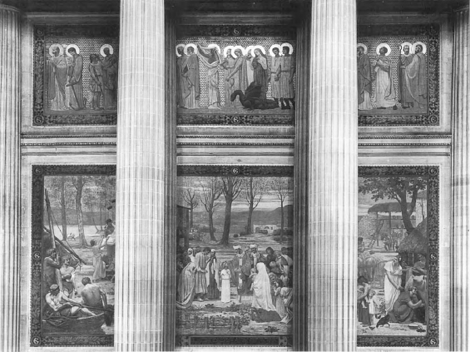 fig. 3
Pierre Puvis de Chavannes, The pastoral life of Saint Genevieve, 1877, oil on canvas, 462 × 221 cm, Paris, Panthéon (photograph courtesy of the Caisse nationale des monuments et des sites, Paris) | |
[pagina 124]
| |
The representation of Saint GenevieveOnly three years before Puvis's first Panthéon commission, the defeat of France in the Franco-Prussian War and siege of Paris had contributed to the revitalisation of St Genevieve in the French imagination. The story of Genevieve, like that of Joan of Arc, with whom she shared many characteristics, had a special appeal after 1870-71. Both were chaste young girls of simple, rustic origins - Genevieve's childhood was often described as a kind of pastoralGa naar voetnoot19 - and both, driven by a powerful faith, were able to lead their imperiled country and save it from foreign invasion. During the Franco-Prussian War, many people prayed for extraordinary intervention, including the military Governor of Paris under the Government of National Defense, Trochu, a man of deep religious faith, who came to believe that St Genevieve would, as she had centuries before, miraculously reappear to deliver the city from the Barbarians.Ga naar voetnoot20 According to legend, in the aftermath of a siege by the Franks, St Genevieve had rescued the starving citizens of Paris by seeing that provisions and food reached them, a deed that resonated all too well with the recent siege, and was to become the subject of Puvis de Chavannes's second round of murals at the Panthéon.Ga naar voetnoot21 Puvis formulated his pictorial ideas for Saint Genevieve as a child in prayer during a moment of cultural and psychological retrenchment that sought to assert historical continuity in the aftermath of defeat. During a period of uncertainty and anti-clericalism, he emphasised the utter modesty, purity, devotion and remove of the young girl's vie pastorale, evoking the simple faith and chastity of earlier times. His settings depicted an idyllic, pre-lapsarian world of uncomplicated activities, earnest faith and natural virtues; they are thus quite closely related to Jean François Millet's depictions of peasants praying in the fields from two decades earlier, and to Paul Gauguin's later portraits of the faithful in Brittany. Puvis's stylistic referents were also suitable to a motif of religious purity. In contradistinction to the classicising cum Renaissance style of his Amiens murals, his major effort during the 1860s, for the Saint Genevieve project he used a self-consciously pre-Raphaelite mode (first broached in his pair of murals for the Poitiers Hôtel de Ville in 1874) that not only reduced the impression of physical salience and actuality of his images, but created a psychic distance that enhanced the meaning of the religious pastoral. By the 1870s, certain styles were considered more appropriate than others to a religious subject, and a primitivising aesthetic, still viewed as curious in some quarters, was beginning to be considered respectable enough for use in certain contexts. The prolific Théophile Gautier, the first critic to champion Puvis's efforts in this direction, had praised Byzantine painting, Giotto and works of a ‘naive’ elegance.Ga naar voetnoot22 And it was this kind of styling, in the best sense, that Puvis employed. There is much about Saint Genevieve as a composition, and specifically the small slip of a girl, that harkens back to an earlier style, particularly to that of a Sassetta or Fra Angelico. Puvis had developed a type of understated, chaste, innocent young girl and presented it in more than one painting: his versions of Hope (Paris, Musée d'Orsay and Baltimore, Walters Art Gallery) of 1872 marked the debut of this kind of figure in his oeuvre. By the mid-1870s, Puvis had come to use older styles purposively for their associations. In response to the legend and in order to evoke the times of St Genevieve and miracles, Puvis chose an earlier, ‘primitive,’ quattrocento style that would connote innocence and faith much as his fellow Lyonnais painter Louis Janmot had in his pre-Raphaelite religious canvases. Moreover, a style issuing from a time closer to that of the historical event must have been meant to lend a note of authenticity to the images.Ga naar voetnoot23 Another aspect of Puvis's archaicising style is his use of colour, redolent of Giotto and Florentine painters such as Fra Angelico. The whitened skin of the figures and the blanched sky, the white-clad, blond Genevieve, the mauve-grey furrowed field and the apricot, white, red and | |
[pagina 125]
| |
yellow flecks for flowers dotting the lime green of the grassy fields, as well as the red-orange skirt of the watching woman are tender, gentle and boldly novel. The cornflower-blue hills in the distance, green tree trunks and turquoise sky are harbingers of Post-Impressionism and even Fauvism. Intent on legibility, Puvis developed a matte, nonreflecting finish without the shading of chiaroscuro, which he abhorred, thus flattening figures and objects. An overall tonality of green, off-white, tan, beige and roseate shades contrasts to the blue tones of his second Panthéon campaign of the 1890s. | |
Preliminary sketches, drawings and oilsPuvis habitually produced many compositional sketches and drawings for various sections of a work, and one or more painted studies and a cartoon before actually embarking on his murals. His first Panthéon project, of enormous importance to his career, evinced a great many preparatory works. Beginning with several dashed off ideas, he worked towards an ever more carefully and tautly arranged picture, with emphasis on the pastoral surroundings and simple background. Some of the more interesting and telling of these works indicate how the artist progressively simplified his composition. Study for Sainte Genevieve as a child in prayer (fig. 4),Ga naar voetnoot24 includes a number of onlookers in the background. These were eventually reduced to the single figure bracketing the composition in a high zone at the back who, while facing the viewer, communicates with and makes him or her into a fellow witness and accomplice (figs. 1 and 2). Of the several landscape variations, one that is considerably flatter and barer includes two onlookers near a large tree in the middle distance. The sheep are already indicated, but Genevieve is not yet framed by the foreground figures (fig. 5).Ga naar voetnoot25 An oil on paper, Study for ‘The childhood of Saint Genevieve,’ dedicated to Puvis's student and protégé, Henri Daras (fig. 6),Ga naar voetnoot26 is a vigorous painted sketch that also includes a number of onlookers and with many other similar elements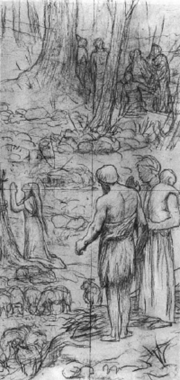 fig. 4
Pierre Puvis de Chavannes, Study for Saint Genevieve as a child in prayer, red and black chalk, 57 × 28.3 cm, Rotterdam, Museum Boymans-van Beuningen (F II 148) | |
[pagina 126]
| |
it would seem to come after the Rotterdam drawing. The girl, dressed in rosy red, is shown amidst small white patches that we know with hindsight indicate grazing sheep. The daubed on colours mark a verdant forested setting. Puvis also executed a very small, highly simplified and schematised drawing of the composition with cursory figures (and no flowers) in ink and pastel on paper (New York, private collection).Ga naar voetnoot27 Coloured in blues and lavenders, it indicates the artist's interest in monochromatic camaieux and the overall tonalities that were to be so important in his own late painting and to 20th-century artists such as Picasso in his Blue Period. Puvis's splendid small watercolour on paper, Landscape with woods and fields (Versailles, private collection), remarkable for its pink furrowed field in the background, has not heretofore been connected to the St Genevieve project.Ga naar voetnoot28 But its high horizons that flatten the image and allow the patterned surface of the tilled field to occupy a large surface area relate it to the Van Gogh Museum study and the definitive painted work. In addition there are a number of drawings of individual figures, fragments and passages,Ga naar voetnoot29 including one with the flock of sheep (fig. 7). One small oil with strong, rather crude and even gummy impasto strokes is somewhat difficult to place within the sequence of development of drawings and painted studies for the Panthéon mural (fig. 8). Details appear (the yellow flowers in the foreground, the twigs above the cross, the direction in which the baby's head is turned) that are in the final mural but not in the Van Gogh Museum composition, indicating it came after the latter. Is this then a problematic painting? There is surprising insensitivity to aesthetic aspects on which Puvis usually set great store: from the indifferently daubed in sheep to the furrowed land in the background, the musculature of the robust foreground figures, the topographical contours and a sensibility to surface rhythms (the trees), and the telling stroke, whether direct or delicate, that is somewhat belied here. Neither signed nor dated, this canvas bears no marks, labels or seals verso. Another preparatory study for Saint Genevieve as a child in prayer (fig. 9) (and a pendant study) once belonged to Prince Eugen of Sweden,Ga naar voetnoot30 who came to study painting in Paris as a young man and, inscribed as a M. Oscarsson, was for a time at Puvis's studio.Ga naar voetnoot31 In many ways similar to the mural, it is more schematised and flatter, with slightly more rigid figures. It is essentially like that of another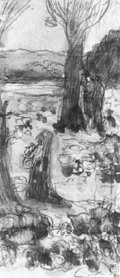 fig. 5
Pierre Puvis de Chavannes, Study for Saint Genevieve as a child in prayer, watercolour, white over black pencil on tan paper, 25.2 × 11.7 cm, Paris, Musée du Louvre (copyright Photo R.M.N.) 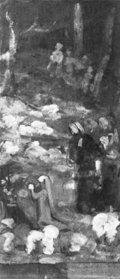 fig. 6
Pierre Puvis de Chavannes, Study for Saint Genevieve as a child in prayer, oil on paper, 56 × 34 cm, inscribed: à mon élève et ami H. Daras P. Puvis de Ch., Varrains (Saumur), private collection 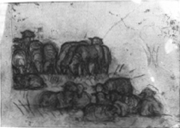 fig. 7
Pierre Puvis de Chavannes, Study of sheep, black chalk on tracing paper, 22.4 × 35 cm, inscribed at lower left (Delapalme inventory): 9e, 11e pièce; stamped twice at lower right: PPC, Var, private collection | |
[pagina 127]
| |
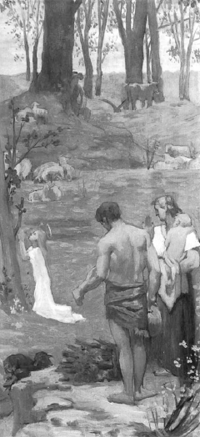 fig. 8
Pierre Puvis de Chavannes, Saint Genevieve in prayer, oil on canvas, 55.3 × 26.4 cm, Paris, Musée du Petit Palais (inv. no. Dut. 1466) 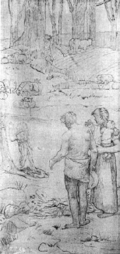 fig. 9
Pierre Puvis de Chavannes, Study for Saint Genevieve as a child in prayer, pen, bistre, and wash drawing on canvas, 112.5 × 53.5 cm, Stockholm, Prins Waldemarsudde Museum (W.112) 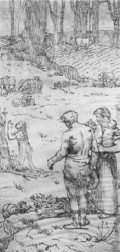 fig. 10
Pierre Puvis de Chavannes, Study for Saint Genevieve as a child in prayer, pen and india ink on silk, 114 × 56 cm, signed at lower left: P. Puvis de Chavannes, Paris, Musée du Louvre (RF 40438 1983) | |
[pagina 128]
| |
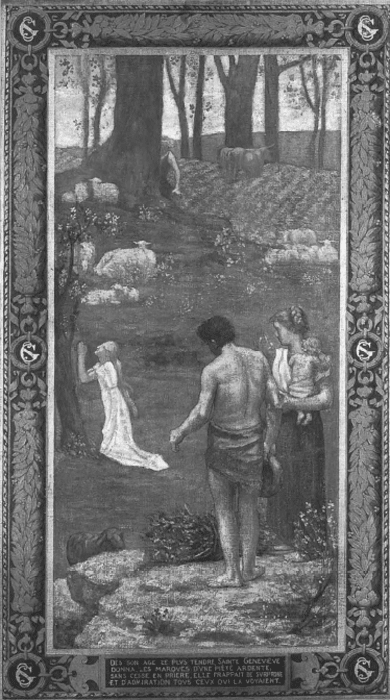 fig. 11
Pierre Puvis de Chavannes, Sainte Geneviève as a child at prayer, 1879, oil on canvas, 134.2 × 77.1 cm, signed at lower left: P. Puvis Ch, Cambridge, Massachusetts, Fogg Art Museum, gift of Grenville L. Winthrop, Class of 1886 (1942. 188) | |
[pagina 129]
| |
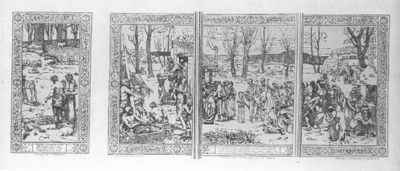 fig. 12
Pierre Puvis de Chavannes, Childhood of Saint Genevieve, 1897, colour lithograph reproduction of poster, 38.9 × 56.7 cm, Kansas City, Missouri, The Nelson-Atkins Museum of Art (Purchase f87-14/2) study, on silk, of the same dimensions (fig. 10). Silk is an exceedingly rare support in Puvis de Chavannes's oeuvre and one might expect this careful, methodical ink drawing to be a presentation work; however, it bears no dedication. Minor variations - the direction of the hatching, the position of the baby's head, and particularly the greater verticality and higher foreground - suggest it is also a preliminary study. Puvis's depiction of the young Genevieve proved particularly appealing and the artist did indeed execute a number of drawings that are set pieces inscribed for presentation. These rather deliberate ink and sepia drawings were probably made once all the work's aspects had been decided on or even after the painting was actually finished. | |
Versions of ‘Saint Genevieve as a child in prayer’The dimensions of the Van Gogh Museum's Saint Genevieve are close to those of a canvas painted after the mural, a reduced version that I would date to 1879 (fig. 11),Ga naar voetnoot32 and each of three canvases after the triad The pastoral life of Saint Genevieve accompanying it, also from 1879 (Pasadena, The Norton Simon Museum Art Foundation).Ga naar voetnoot33 In the 1860s, keen on achieving recognition and aware that it was difficult with his works so widely dispersed, Puvis began to execute reduced versions of his monumental paintings. He painted his first réductions after his early public murals installed at Amiens - Concordia and Bellum of 1861 and Le travail and Le repos of 1863 - to exhibit at the Exposition Universelle of 1867. Aside from their difference in scale, these reproductions approximate the definitive paintings and contrast to the freer, often more spontaneous, but cruder, blunter and less completely worked-out preliminary studies. In the case of the Saint Genevieve reductions, a broad technique gives them the appearance of murals by approximating the effect of the viewing distance needed to understand their grands traits. That is, although the technique of mural and reduction is similar - strokes and dabs of relatively dry paint with light tones scumbled over neutral colours, a porous, granular surface and patches of rough colours - because of the disparity of size between mural and reduced version, the effect of each differs: the reduced versions appear to be far more broadly painted. As late as the end of the 1890s coloured, posterlike lithograph reproductions (fig. 12) after Puvis's first Panthéon murals were published by the firm of Lemercier | |
[pagina 130]
| |
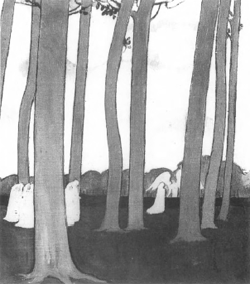 fig. 13
Maurice Denis, The green trees, 1893, oil on canvas, 46.3 × 42.8 cm, Private collection for the Union pour l'action morale.Ga naar voetnoot34 These affiches morales were part of a movement to combat what were thought by some to be overly frivolous and licentious posters, such as those by Jules Chéret, which had proliferated in Paris in the 1890s. In an article of 28 September 1896, Gustave Geffroy wrote: ‘The entrepreneurs of these “moral posters,” lithographed after Mr Puvis de Chavannes's Sainte Geneviève, which have been set against each other on a wall of the Boulevard des Capucines (I don't think they have been seen elsewhere), had, however vague, the intentions of moral preaching, for there is definitely a moral here, whatever it may be.’Ga naar voetnoot35 | |
The influence of the paintingImages played an important role in establishing Genevieve in the popular imagination. Puvis de Chavannes's monumental cycle of murals at the Paris Panthéon are probably the best known works devoted to her. The originality of the highly simplified and abstracted St Genevieve project was recognised by both sympathetic and less sympathetic viewers; it was purportedly Henry James who described the work as ‘simplicity at any price.’Ga naar voetnoot36 Aside from the general influence that Puvis de Chavannes had on more than one generation of artists - a subject too large to be broached hereGa naar voetnoot37 - his Panthéon programmes, and particularly the panel for which the Van Gogh Museum composition is a study, proved significant for a number of younger painters. Puvis's Panthéon paintings were a fundamental contribution to the Modernist pictorial vision. Maurice Denis and Pablo Picasso were among the painters who produced pictures directly indebted to | |
[pagina 131]
| |
these images. What made Puvis's work so commanding - his particular aesthetic - can be perceived even more readily in their paintings. It was in the midst of a discussion of Puvis's work that Maurice Denis, who often wrote about the older artist, offered his famous dictum ‘Remember that a painting - before being a warhorse, a nude woman, or some anecdote - is essentially a planar surface covered with colours organised in a certain order.’Ga naar voetnoot38 Indeed, the formal disposition of figures and silhouetted trees in the Saint Genevieve as a child in prayer would prove important for him.Ga naar voetnoot39 The rhythmic alternation of slender and broad trees in the background may well have been the impetus for Denis's own flattened, outlined, all-but-abstracted trunks snaking up the canvas in The green trees (fig. 13). Puvis's sensuality was one of understated colours, ordered form and surface textures, patterns and rhythms; he was thoroughly modern in quietly revelling in just these elements, and Denis recognised this. Puvis's work meant a great deal to the young Picasso, who came to Paris from Barcelona three times at the turn of the century:Ga naar voetnoot40 in 1900, from June 1901 to January 1902, and from 29 October 1902 until January 1903. The Panthéon murals were among Puvis's most accessible works,Ga naar voetnoot41 the second cycle of which he had been completing upon his death in 1898. The blue tonal cast of the latter, after which Picasso copied passages, were, of course, to have a crucial effect on his works from about 1902-05, those of the famous Blue Period. But Picasso was also attracted to the earlier Panthéon murals. One of the most interesting drawings in his sketchbook, dating from December 1902 and usually called The Golden Age (fig. 14), is based on that cycle. Much of the configuration of Puvis's composition,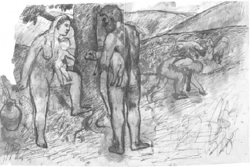 fig. 14
Pablo Picasso, The Golden Age, December 1902, pen and watercolour on paper, 26.1 × 40 cm, Barcelona, Museu Picasso (MAB 110.469) 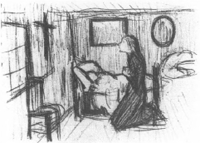 fig. 15
Pablo Picasso, Woman praying at a child's deathbed, 1899-1900, conté crayon on paper, 17 × 23 cm, Heirs of the artist | |
[pagina 132]
| |
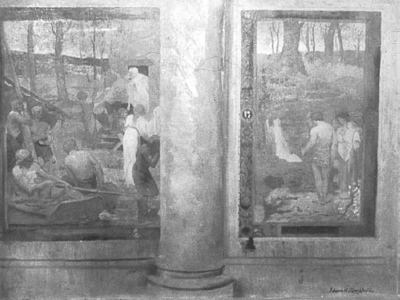 fig. 16
Edwin Blashfield, Copy after Puvis de Chavannes's Saint Genevieve murals at the Paris Panthéon, oil on canvas, 53.3 × 71.1 cm, whereabouts unknown although altered, is repeated here: the sturdy figures, the couple with a baby, the prominent tree, the raised horizon, even a sheep. Most striking is the chunky man, his back to the viewer, who (with the exception of one arm) is all but a precise copy of Puvis's hardy rustic. Picasso appreciated the amplitude and corporeality of these figures, a type not always associated with Puvis's work. Further use of the broad-backed man from Saint Genevieve as a child in prayer has been noted in the powerful seated male turned away from the viewer in Picasso's Young acrobat cm a ball (Moscow, Pushkin Museum).Ga naar voetnoot42 Although perhaps too common a motif to be ascribed to one source, Picasso's Woman praying at a child's bedside (fig. 15) is an exceedingly close approximation of Puvis's kneeling young saint. The American artist Edwin Howland Blashfield, a leader in the American mural movement who would go on to produce important works in the United States - for example, at the Library of Congress in the 1890s - like so many of his compatriots studied art in Paris (under Bonnat and Gérôme), and also copied Puvis de Chavannes's Panthéon murals (fig. 16). The Saint Genevieve as a child in prayer is on the right in his canvas; in the very centre he placed a large column that approximates those at the site; and to the left - out of order, but perhaps not inexplicably - is copied the panel that in truth is several panels further away to the left, at the left of Puvis's triptych (itself to the left of the praying Genevieve). This new juxtaposition places together images that nicely bracket Blashfield's composi- | |
[pagina 133]
| |
tion at right (the praying child) and left (the so-called Samaritan wing of the Panthéon triad), and proves less unwieldy compositionally (the section of the triad there designed to be to the right of the central panel) than the two neighbouring panels actually at the Panthéon. Blashfield was far from alone in his ardent admiration for Puvis and unabashedly admitted that he ‘worshipped at the shrine of his Sacred Grove.’Ga naar voetnoot43 Another of Puvis's great admirers was Vincent van Gogh, who was both influenced by and wrote about his work.Ga naar voetnoot44 He spoke poignantly about the quiet of Puvis's Edenic pastorals and was also much taken with the beauty of his colours, which he described with both great subtlety and specificity. The idyllic mood Vincent marvelled at pervades the Saint Genevieve as a child in prayer. It is particularly fitting that a museum devoted to Van Gogh should now own this superb example of Puvis's work, a touching devotional painting whose sentiments of honesty and religious yearning echo those so often expressed by the Dutch painter himself. |
|

